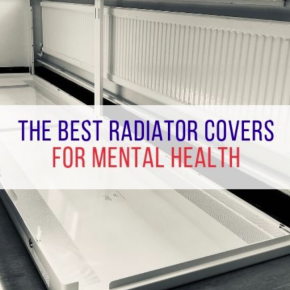
The best radiator covers for mental health
Contour explores what makes the best radiator cover for mental health environments, what to avoid and why.
When designing a living environment for mental health service users, a number of factors are at play. Firstly, you have the challenge of creating a safe environment where the element of risk is greatly reduced or minimised. Behaviours in mental health facilities are often unpredictable, which could lead to dangerous and sometimes even life-threatening situations. Designing a space where this risk is minimised is key when considering furniture and appliances.
Secondly, you should consider the aesthetics of the environment. Research suggests that the design of mental health settings can reduce stress and aggression amongst service users (Ulrich et al. 2018). When designing a mental health facility, attention must be placed on creating a calm, pleasant atmosphere.
Taking these key factors into account, every design choice you make can either positively or negatively affect the service user, either enhancing or restricting a patient’s sense of belonging and increasing or reducing feelings of physical security, promoting or reducing mobility, and improving or having a negative outcome on patients’ health.
7 Key Features To Look Out For
When choosing your radiator covers, we recommend that you take certain features into account. Use the following list as a ‘crib sheet’-if necessary-and ask yourself,
‘Does my radiator cover meet these specifications?’
1. Anti-ligature. An anti-ligature product is one that minimises the risk of a person attaching anything to it that could inflict harm to themselves or anyone else. When choosing a radiator cover, we recommend that you always consider whether there are any ligature points.
2. No sharp or jagged edges. This one seems a little obvious, but it’s worth running your hand along the whole cover, including the bottom, back, and sides. Any sharp element could be used to self-harm individuals or other service users. Additionally, sharp/jagged edges could be used to inflict further damage to the cover.
Sharp elements can also be created by grilles that are placed over the ‘fold’ of the radiator cover. When someone aggressively runs their skin along a fold that contains grilles, it could act as a self-harming tool.
3. Robust edges and bullnose corners. Bullnose corners are essentially rounded corners that provide a smooth edge. Traditionally used in construction and masonry, bullnose corners are an excellent feature to look out for when considering a radiator cover for safety purposes.
4. Strength. We recommend a metal that is 1.5 mm thickness or above. This will provide you with the quality and longevity that is required in mental health environments. A product that is less likely to get damaged is something worth noting. 1.5mm metal might not seem like a lot, but when compared to a 1.2mm casing, the difference is substantial.
There are times when a thicker metal is necessary. We have in the past made covers from 2 to 3mm thick Zintec Steel for areas that are notorious for being vandalised, such as 136 suites/de-escalation rooms.
5. Small Grilles. Linking in with the anti-ligature feature, it’s important to consider the size of the grilles. Many individual NHS Mental Health Trusts have adopted the advice outlined in the Home Office Police Buildings Design Guide – Custody, July 2009, Section PD3.02.14, which details that grilles, unless otherwise specified, should be perforated with 2mm holes, in a triangulated pattern.
The section in the Home Office document specifically relates to ventilation grilles-but it’s the only official government guidance in relation to hole size-that exists.
6. No gaps on joints. We recommend you choose a full-framed design with minimal gaps on joints. For individuals who are looking to damage appliances, you should look to avoid any opportunities for objects to be placed or wedged in any joins within the design.
7. Minimal gaps from frame to wall. Whilst it is virtually impossible to create zero gap between cover and wall-particularly when larger radiator covers are required-you should always seek for ways to reduce frame to wall gaps as much as possible.
Look to see if installers use ‘anti-pick mastic’. Anti-pick is specifically designed for providing a fingerpick resistant
seal, accommodating small movement for areas where a normal sealant is not hard enough.
Get these seven key features underpinned, and you’ll be providing patients with the highest possible quality of care. Many of the key features outlined above could be applied to several appliances when considering the design of your mental health setting. The key point here is that you want to ensure your choices reflect a need for longevity, safety, and quality.
Cleaning Considerations
Let’s say you’ve made the decision to choose a full-framed, robust radiator cover. A key consideration here, however, is how you clean a radiator that might appear to be difficult to access. With hygiene being such a high priority in mental health environments, maintaining cleanliness should not be a difficult task.
With that in mind, look for a cover with an opening that can be removed efficiently whilst ensuring that no gaps arise at any point between frame and door. At this point, consider how the radiator cover opening can be accessed. Do you need a particular key to secure the frame to the door? The best radiator covers are ones that only provide cleaning access to authorised personnel via a locking key.
Going That Extra Mile
When choosing the best radiator covers, aim for a product that goes that extra mile. Does it have features that you hadn’t even considered a priority?
Radiator covers that are coated in anti-microbial protection, such as BioCote® provide protection against a wide range of microbes such as bacteria, mould, and even some viruses.
Additionally, you should aim to request a free of charge site survey to ensure that your needs are truly met, with the most suitable product for the environment that the covers are going to be installed in. The best radiator covers are the ones that go beyond the obvious safety standards and offer additional features that are also of high importance.
It’s Ok To Consider The Aesthetics
There’s an assumption that functionality and safety override the actual look of a product. In many cases, this is true. You don’t want a product that looks great but doesn’t serve its primary purpose. But… A radiator cover that is both safe, functional and aesthetically pleasing makes for an effective all-round product.
As mentioned at the beginning of this post, a calm, aesthetically pleasing environment can positively impact service users’ mental wellbeing. Therefore, appliances such as radiator covers should be designed to fit in with the environment’s overall aesthetic. They shouldn’t be ugly. They shouldn’t stand out.
When choosing the best radiator covers for your environment, Contour recommends that you don’t compromise on the aesthetics. Choose an option that is bespoke to your needs.
Click here to download Contour’s colour psychology Ebook, and click here to explore a range of colour options.
Contour can be contacted at;
The Mansions
43 Broadway
Shifnal
TF11 8BB
Tel: 01952 290 498
Email: [email protected]
Visit Supplier's page
Latest news

26th April 2024
Hush Acoustics optimises fleet operations by securing FORS Gold accreditation
Hush Acoustics has invested in the safety and sustainability of its commercial vehicle fleet by achieving Gold status in the Fleet Operator Recognition Scheme (FORS).
Posted in Acoustics, Noise & Vibration Control, Articles, Building Industry News, Building Products & Structures, Building Regulations & Accreditations, Building Services, Ceilings, Facility Management & Building Services, Floors, Health & Safety, Insulation, Restoration & Refurbishment, Retrofit & Renovation, Site Preparation, Sustainability & Energy Efficiency, Walls, Waste Management & Recycling
26th April 2024
Safeguard Europe: Penetrating damp - how to diagnose the damage
As Safeguard gets ready to deliver another informative session of one of its most popular webinars, the company outlines some of the most common reasons for rain penetration through brickwork.
Posted in Articles, Bricks & Blocks, Building Industry Events, Building Industry News, Building Products & Structures, Building Services, Continuing Professional Development (CPD's), Damp & Waterproofing, Facility Management & Building Services, Information Technology, Posts, Render, Restoration & Refurbishment, Retrofit & Renovation, Seminars, Training, Walls
25th April 2024
ADSA: Competence Initiative Makes Progress
The Joint Competency Initiative (JCI), in which the Automatic Door Suppliers Association (ADSA) is involved, is finalising its first framework for installers within the door, gates and shutter industry.
Posted in Access Control & Door Entry Systems, Architectural Ironmongery, Articles, Building Associations & Institutes, Building Industry Events, Building Industry News, Building Products & Structures, Building Regulations & Accreditations, Building Services, Continuing Professional Development (CPD's), Doors, Facility Management & Building Services, Health & Safety, Innovations & New Products, Publications, Research & Materials Testing, Restoration & Refurbishment, Retrofit & Renovation, Security and Fire Protection, Site Preparation
25th April 2024
BMBI: Value sales in first two months were -3.4% down
The latest Builders Merchant Building Index (BMBI) report shows builders’ merchants’ value sales were down -4.7% in February compared to the same month a year ago.
Posted in Articles, Bathrooms & Toilets, Bathrooms, Bedrooms & Washrooms, Bricks & Blocks, Building Associations & Institutes, Building Industry News, Building Products & Structures, Building Services, Civil Engineering, Concrete, Cement, Admixtures, Drainage, Floors, Hard Landscaping & Walkways, Interior Design & Construction, Interiors, Landscaping, news, Paints, Paints, Coatings & Finishes, Plant, Equipment and Hire, Plumbing, Posts, Publications, Research & Materials Testing, Restoration & Refurbishment, Retrofit & Renovation, Sustainability & Energy Efficiency
 Sign up:
Sign up: